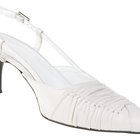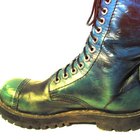
Martin Poole/Lifesize/Getty Images
Gluing inserts into a pair of shoes is beneficial to anyone needing orthotic comfort and support to prevent knee, hip or back issues, tendinitis, or simple blisters that develop from the use of standard insoles. There are a number of brands on the market that are designed for better shock absorption and improved fit for any activity. Though these types of insoles are often associated with athletics, they can be used in any type of shoe that needs increased arch support or protection for the ball of the foot.
Purchase the right kind of insoles for the needs of your feet and size of the shoes. Some insoles are designed to relieve specific ailments like knee pain and arthritis. Not all manufacturer's sizes are alike, so most insoles are built to fit a small range of sizes. Keep these in mind when choosing the right insole.
Remove the insole and any other material that is currently inside the shoe. New inserts work best when they lay flat on the bottom of the shoe. There should be nothing lying beneath the new insole or they will not work properly.
Place the old insole over the new insert, matching the heel and the arch-side edge together and trace a line around it. If there is no insole in the shoe, place the shoe on top of the new insert and trace a line around that.
Cut carefully along the traced line with a pair of scissors. Be sure to stay as close to the markings as possible, as the insert shouldn't be too small inside the shoe or too large as to fit improperly.
Glue the insoles into the shoes. Apply an adhesive product such as Shoe Goo or Cobbler's Cement to the bottom of the insole and the surface of the inside of the shoe. Let it sit for about two minutes before placing the insole inside of the shoe, allowing both surfaces to bond together. Press down to ensure the insole lies flat and there are no areas that are sticking up. Allow the bonds to seal for 24 hours before wearing the shoes.
Break in the new inserts with repeated use. Most new inserts may feel uncomfortable when they are first installed, despite careful selection of the correct size and benefit. The breaking-in process will gradually mold the inserts to your feet so that they are comfortable. If discomfort persists after five to seven days, remove the insoles to avoid injury.
Related Articles

How to Use Inserts With Dansko ...

How to Fix a Slingback Shoe

How to Make Your Sneakers Fit Better if ...

How to Add Arch Support to Shoes

How to Clean Superfeet Foot Insoles

How to Stop Crocs From Making Noise

How to Stop a Heel Slip

How to Keep Shoes From Rubbing the Heel

How Do I Stretch a Pair of Alligator ...

How to Keep Toes From Squeezing Out of ...

How to Make Shoes 1/2 Size Smaller

The History of Steel Toe Boots

How to Repair a Split Rubber Sole

How to Repair and Remove the Steel Toe ...

How to Fix a Nike Cortez If the Sole Is ...

The Best Cushioned Shoes for Overweight ...

How to Stop Clog Shoes From Squeaking

How to Give Your Shoe Grip

Solutions for Shoes That Are a Half ...

The Best Glues to Attach Inner Soles
References
Writer Bio
Marc Gottlieb has been writing since 1997, when he was hired as a guest columnist for "Films in Review" magazine. He now serves as a full-time writer and contributor to several online publications. Gottlieb attended the School of Visual Arts in New York City.
Photo Credits
Martin Poole/Lifesize/Getty Images